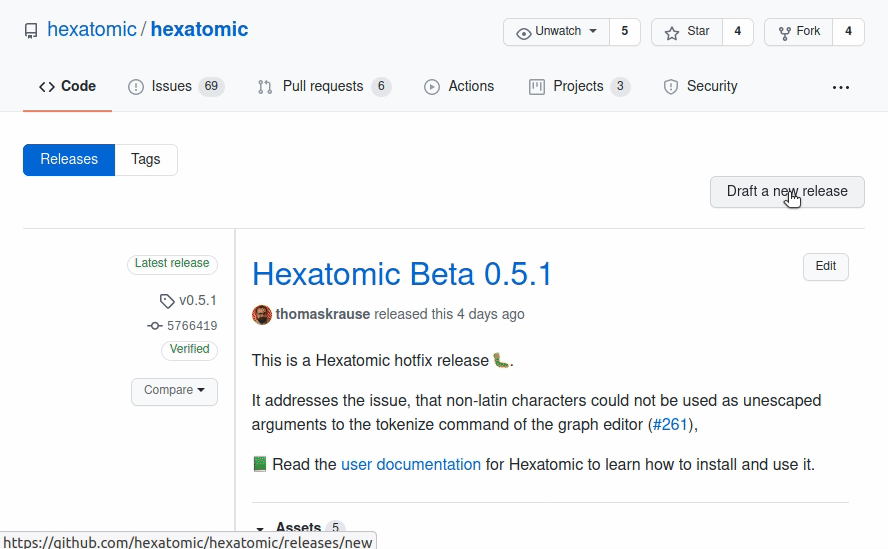Releases
Releases are versions of Hexatomic that are marked as encapsulating a specific set of tested and documented functionality features or repairs. Releases have a version identifier and are listed on the releases page in the Hexatomic repository.
When to create a release
Hexatomic is a dynamic software project, and therefore there is no release plan with fixed dates for releases. Instead, the maintainers of Hexatomic decide when to create a new release. There are, however, two ground rules for when a release is created:
- Whenever a bug in a previous release of Hexatomic is hotfixed, a new hotfix release must be created.
- Whenever new functionality has been implemented and merged into the
developbranch, a new feature release should be created.
Feature releases
To release a new feature (i.e., minor) version of Hexatomic, run the following commands in the repository root directory.
git checkout develop- Checks out the develop branch (feature releases are always based ondevelop).git pull origin develop- Updates the local develop branch.mvn clean install- Builds the project, runs tests, and may update the file headers in Java files.git add .- Adds the updated files - if any - to the Git index. Make sure you only add intended changes.git commit -m "Update file headers"- Commits the updates to version control.git push- Updates the remote develop branch.mvn gitflow:release-start- Starts the release process.- The Maven GitFlow plugin will then prompt you to enter a version number for the release. Make sure you enter a version identifier according to semantic versioning, in the format
MAJOR.MINOR.PATCH. Do not use a-SNAPSHOTsuffix! - Check if the
[Unreleased]changelog section inCHANGELOG.mdis complete and up-to-date. Make changes, commit and push if necessary. mvn keepachangelog:release -N- Updates the changelog in the release branch.git add CHANGELOG.md- Adds the updated changelog to the Git index.git commit -m "Update changelog"- Commits the updated changelog to version control.git push- Updates the remote release branch.mvn gitflow:release-finish- Finalizes the release process.
Hotfix releases
Hotfixes come into the project via pull requests of a hotfix branch against master.
Important: Do not merge pull requests from hotfix branches into master!
Instead, checkout the hotfix branch locally, and start the merge and release process with the Maven GitFlow plugin:
git checkout hotfix/{hotfix version}- Checks out the respective hotfix branch.git pull origin hotfix/{hotfix version}- Checks for any remote changes to the branch.mvn clean install- Builds the project, runs tests, and may update the file headers in Java files.git add .- Adds the updated files - if any - to the Git index. Make sure you only add intended changes.git commit -m "Update file headers"- Commits the updates to version control.git push- Updates the remote hotfix branch.- Check if the
[Unreleased]changelog section inCHANGELOG.mdis complete and up-to-date. Make changes, commit and push if necessary. mvn keepachangelog:release -N- Updates the changelog in the release branch.git add CHANGELOG.md- Adds the updated changelog to the Git index.git commit -m "Update changelog"- Commits the updated changelog to version control.git push- Updates the remote release branch.mvn gitflow:hotfix-finish- Finalizes the hotfix and finishes the merge and release procedure.
Promoting releases on GitHub
When you have made a feature or hotfix as described above, you will find a new tag for the released version on the Hexatomic releases page on GitHub.

You can now make a release from this tag:
- Click on Draft a new release on the Releases page.
- Complete the Tag version field with the tag you want to release (e.g.
v0.4.1). - Give the release a title. It should start with
Hexatomic, include any necessary qualifiers (e.g.,Betaif it's a0.MAJOR version) and the version number itself without any prefixes (e.g., use0.4.1instead ofv0.4.1). - Describe the release in three parts:
- A high-level description of the form
This is a Hexatomic <hotfix/feature> release <:bug:/:tada:>!followed by a blank line. - A short description of the fix (including issue numbers with hash prefixes, e.g.
#123) or the added functionality. You can use bullet lists if more than one fix or feature has been added. - A link to the user documentation with, e.g., the following text:
:green_book: Read the [user documentation](https://hexatomic.github.io/hexatomic/user/v0.5/index.html) for Hexatomic to learn how to install and use it.Make sure you get thevMAJOR.MINORpart in the documentation URL right.
- A high-level description of the form
- Click the Preview tab and check if everything looks good.
- Click on the green Publish release button. You can always delete and re-create releases from tags if something goes wrong.
- Check if the release contains all "binaries", i.e., the product .zip files for all three major operating systems.

What to do when releases go wrong?
When a feature release doesn't work as expected, simply
- Checkout the
developbranch (git checkout develop). - Delete the release branch for the version you wanted to release (
git branch -d release/{version}). - Delete the same branch on GitHub (via the web interface).
- Restart the release process from the top.
When a hotfix release doesn't work as expected, simply
- Make the necessary changes in the hotfix branch, then continue with the merge and release process.